MXA RACE TEST: 2019 YAMAHA YZ85
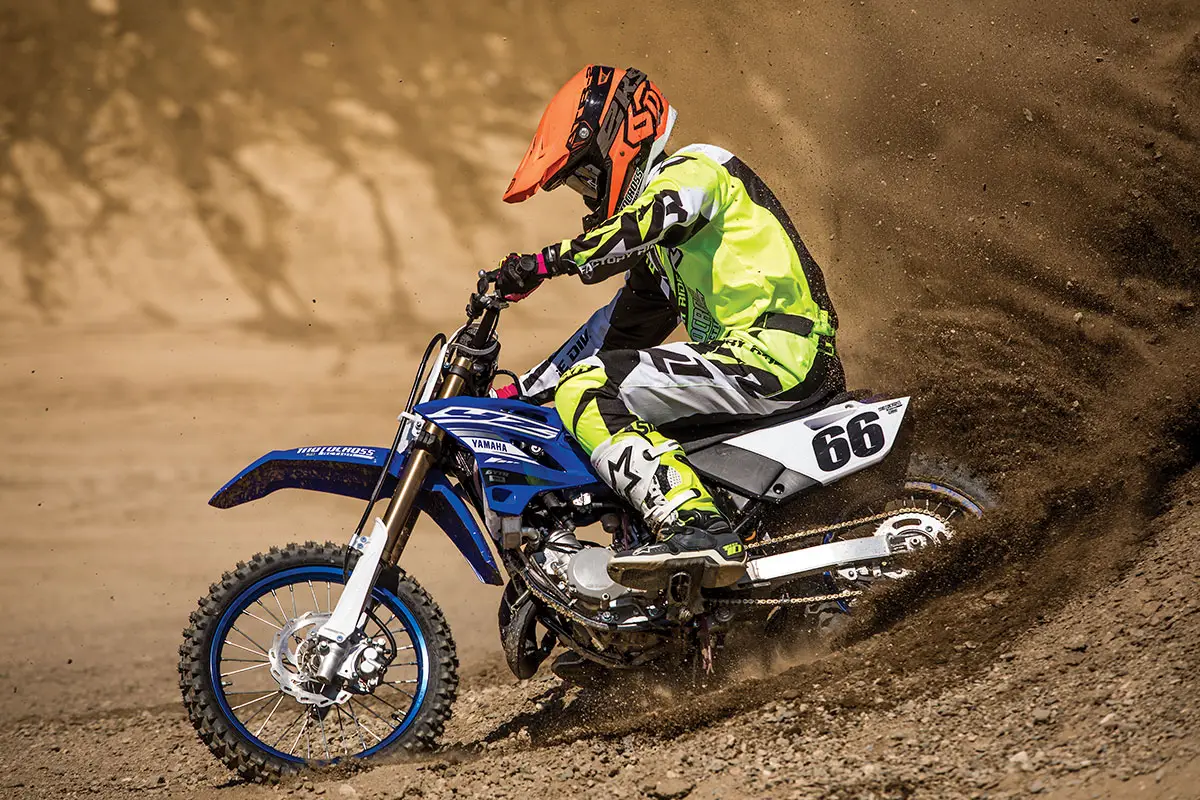
Q: IS THE 2019 YAMAHA YZ85 BETTER THAN THE 2018 YZ85?
A: Yes. It is an improvement from the 2018 model. But, the 2018 YZ85 was virtually the same as the 2002 YZ85. From 2002 to 2018, the YZ85 had the same cylinder, head, cases, pipe, silencer, carburetor, frame and, for the most part, the same engine. The 16-year-old bike was growing long in the tooth. It hasn’t been competitive in its class for years now. Sounds like a familiar complaint about the rest of the YZ two-stroke line. Yamaha finally decided to revamp the old dog. The million-dollar question is, was it enough to bring the YZ85 into competitive territory with the KTM 85SX, TM 85MX, KX85 and TC85?
Q: WHAT IS NEW AND WHAT IS OLD ON THE 2019 YZ85?
A: Let’s start with the old. Some parts that carried over from the 2002 to 2018 model are the silencer, front and rear calipers, Keihin PWK 28mm carburetor (although it has different jetting), shock body (different settings) and frame. The plastic was revamped in 2015 and wasn’t changed for the 2019 model. Here is a list of what is different.
(1) YPVS. One of the biggest updates on the YZ85 engine is the addition of the YPVS (Yamaha Power Valve System). This is a dual-valve mechanical system. The YPVS begins to open and operate at 8500 rpm and is open fully at 9000 rpm. When the YPVS is open, the compression increases from 8.1:1 to 8.2:1. When the YPVS is closed, the compression ratio is significantly higher than the 2018 model’s at 9.6:1 compared to 8.1:1.
(2) Bottom end. The crankcase shape was changed to optimize charge flow and increase the compression ratio. The crankshaft assembly has been updated with a 4mm-shorter connecting rod and a resin weight added to balance the crank.

(3) Top end. The cylinder has a new combustion chamber shape to work in unison with the new Power Valve system.
(4) Transmission. Third and fourth gears have a wider base to increase strength and provide smoother shifting.
(5) Reed block. Yamaha went with a spacer-style reed block that offers 0.1mm-thicker reed pedals.
(6) CDI box. The mapping in the CDI box has been changed to match the updated engine.
(7) Water pump. The water pump housing and exit pipe are all new.
(8) Pipe. The exhaust pipe has new dimensions for 2019.
(9) Forks. The 36mm KYB spring forks have a more rigid outer tube with updated settings.
(10) Swingarm. The new swingarm is stiffer and has a new chain guide and an updated chain adjuster system.
(11) Front brake. The brake hose routing system is more direct, and the rotors are wave-style front and rear. The rear rotor is a solid disc (it has no holes, as it reduces heat better).
(12) Adjustments. Yamaha made the YZ85 more compliant for different size riders. They did this by using four-position adjustable bar mounts and adjustable-reach clutch and brake levers. 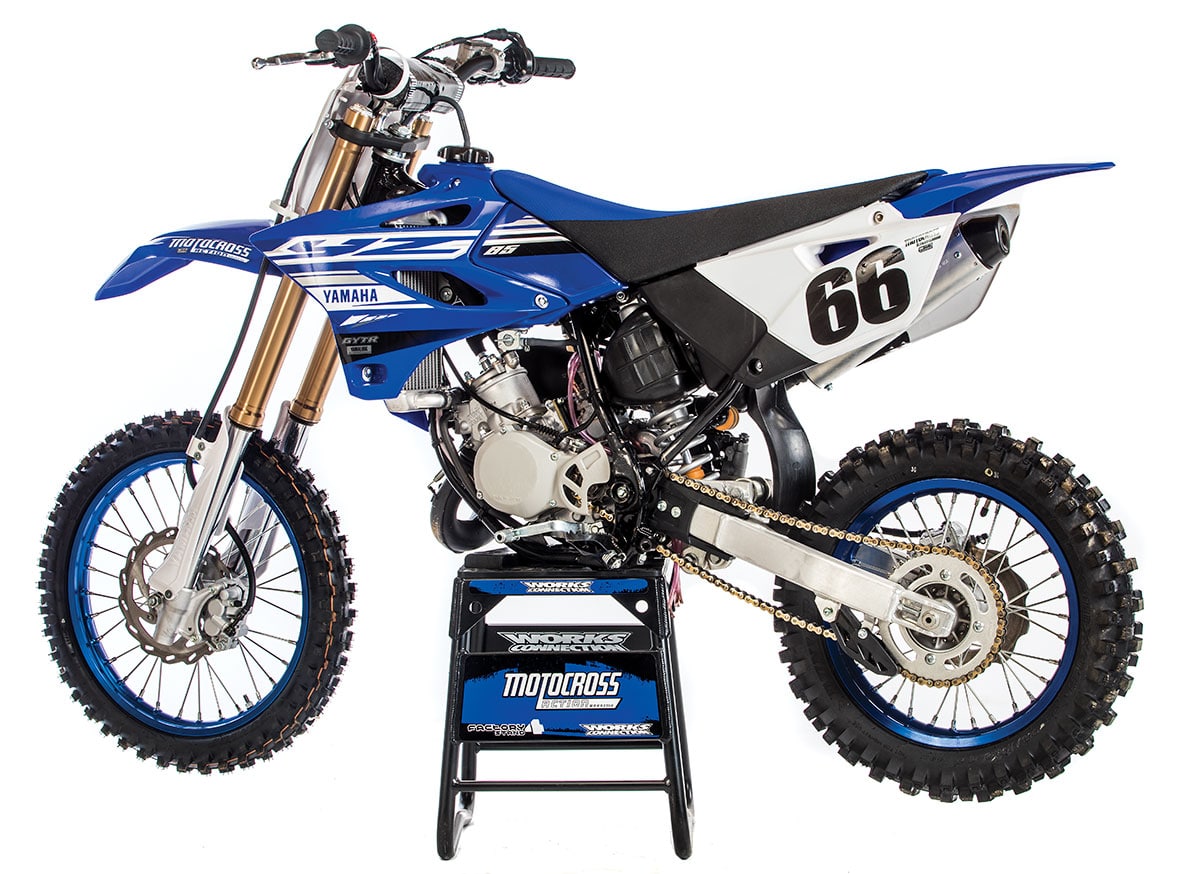
The updates to the 2019 Yamaha YZ85 make the bike an all-around better package.Q: HAVE THE DIMENSIONS CHANGED ON THE YZ85?
A: Not much. The wheelbase is a tad shorter (0.1 inches). The rake (or caster angle) is kicked out 0.13 degrees, and the highest point of the bike (the bars) is 0.8 inches taller. Its length, width, seat height and trail are all the same.
Q: HOW MUCH DOES THE 2019 YAMAHA COST?
A: We are happy to say that the YZ85 price didn’t skyrocket with all the changes, but Yamaha did raise the price by $300 from $4299 to $4599. How does that compare to the prices of its competitors? The Suzuki RM85 (yes, they still make it) has the lowest price point of $4199 (as it should). The Kawasaki KX85 is second cheapest at $4349. The YZ85 fills the gap above the KX85 but below the $5899 KTM 85SX. The second-most expensive minicycle is the Husqvarna TC85 at $5999, and the most expensive 85cc machine on the planet is the TM 85MX at an astonishing $8199—which is the same price as a brand-new 2019 YZ250F.

Q: HOW GOOD IS THE UPDATED ENGINE?
A: It is a much better engine without producing any more peak power or torque than its predecessor. How can that be? The power is broader from bottom to top. The old YZ85 engine would hit hard, jerk you back in your seat, and then suddenly give up the ghost. The 2019 powerplant responds much quicker from the crack of the throttle and doesn’t hit any dips—making for smoother power. Don’t mistake smooth for slow, because that isn’t what we are saying. It is significantly faster off the bottom and has a much calmer transition to the midrange without the abrupt hit. It revs through its powerband quicker. The numbers tell the story.
The 2019 YZ85 offers a full 2 horsepower more from 7000 to almost 8500 rpm compared to its predecessor. Two ponies might not sound like a lot, but for a YZ85 that is close to a 10 percent increase in power. The 2019 powerband mimics the old engine’s curve from 8700 rpm to almost 10,000 rpm. From 10,200 to 11,200, the 2019 YZ85 dips down a horsepower but then has one last surge of power from 11,200 to 11,700 to bring it up to par with the old engine at peak.
The bump in power from low to mid makes the power rev through its range faster. This makes the gear ratios feel closer together. Also, the new engine falls off 300 rpm sooner than the old one, which doesn’t help it any. Yamaha band-aided this issue by using taller gearing (going from a 47-tooth to 46-tooth rear sprocket). MXA’s test riders insisted on trying even taller gearing. Maybe Yamaha needs to lengthen the gaps between a few gears. Test riders also felt the 2019 engine’s broader powerband made it easier to keep it on the pipe, in turn making it easier to manage, especially for less skilled riders. The old engine was hard to control, as the powerband was very abrupt and your left hand would get tired from fanning the clutch to get the power into its small sweet spot.
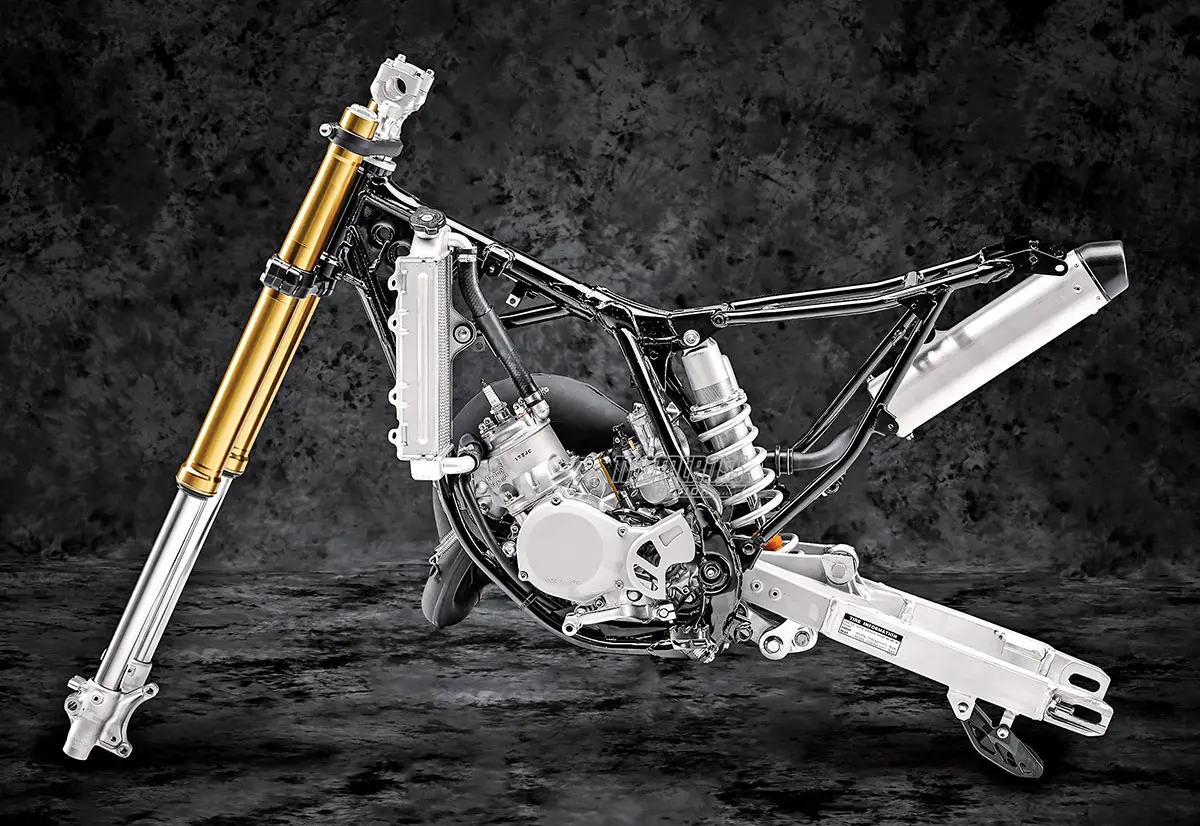
Q: IS IT COMPETITIVE?
A: Yes and no. It beats out its Japanese competitors, the KX85 and RM85, by producing 23.49 horsepower and 10.61 pounds of torque—both of which are smaller numbers than the previous YZ85 engine; however, Yamaha’s engineers knew that with the limited budget they had they weren’t going to match the KTM 85’s 25 horses and they were already outperforming the KX85’s 22.68 ponies. On paper, the old-school Yamaha YZ85 wasn’t a bad bike, although the dirt dyno told a different story. Yamaha knew that if they filled the huge hole in the bottom and midrange, the YZ85 would feel like a much-improved bike on the track. Mission accomplished. The 2019 Yamaha YZ85 might not be blazingly fast like the KTM 85SX, TC85 or TM 85MX, but it is a bike that has its charms.

Q: HOW DOES IT HANDLE?
A: Every test rider felt it handled much better than its predecessor. The front and rear KYB components worked great. Riders didn’t have anything bad to say; however, many of our testers complained about the YZ85 chassis suffering from head-shake. We tried lowering the forks into the clamps and dropping the sag, but for our smaller testers it wasn’t enough. The trade-off was its impeccable turn-in.
Q: WHAT DO WE HATE?
A: The hate list:
(1) Head-shake. This bike turns on a dime but shakes at speed.
(2) Gearing. Riders complained about feeling they were between gears as well as the gear ratios being too close together.
(3) Subframe. Some of our test riders’ boots got caught on the lower subframe bolt.
(4) Gas cap. It is too hard to get off, and the thread pitch is too fine.
(5) Weight. It is heavy in comparison to its Austrian competition.
(6) Fork lugs. They drop so far below the front axle that they drag in ruts.
(7) Chain guard. The front chain guard can’t be removed without taking off the stator cover.
Q: WHAT DO WE LIKE?
A: The like list:
(1) Suspension. The KYB forks and shock were great for riders big and small.
(2) Price. It is $1500 cheaper than the Husky TC85. That is a lot of money to buy spare parts or upgrade the bike to your liking.
(3) Bars. Every rider liked the Pro Taper bar bend.
(4) Engine. The power is a big improvement over its predecessor but not enough to be competitive in the stock class at Loretta’s.
(5) Levers. The adjustable levers are a nice touch for taller riders.
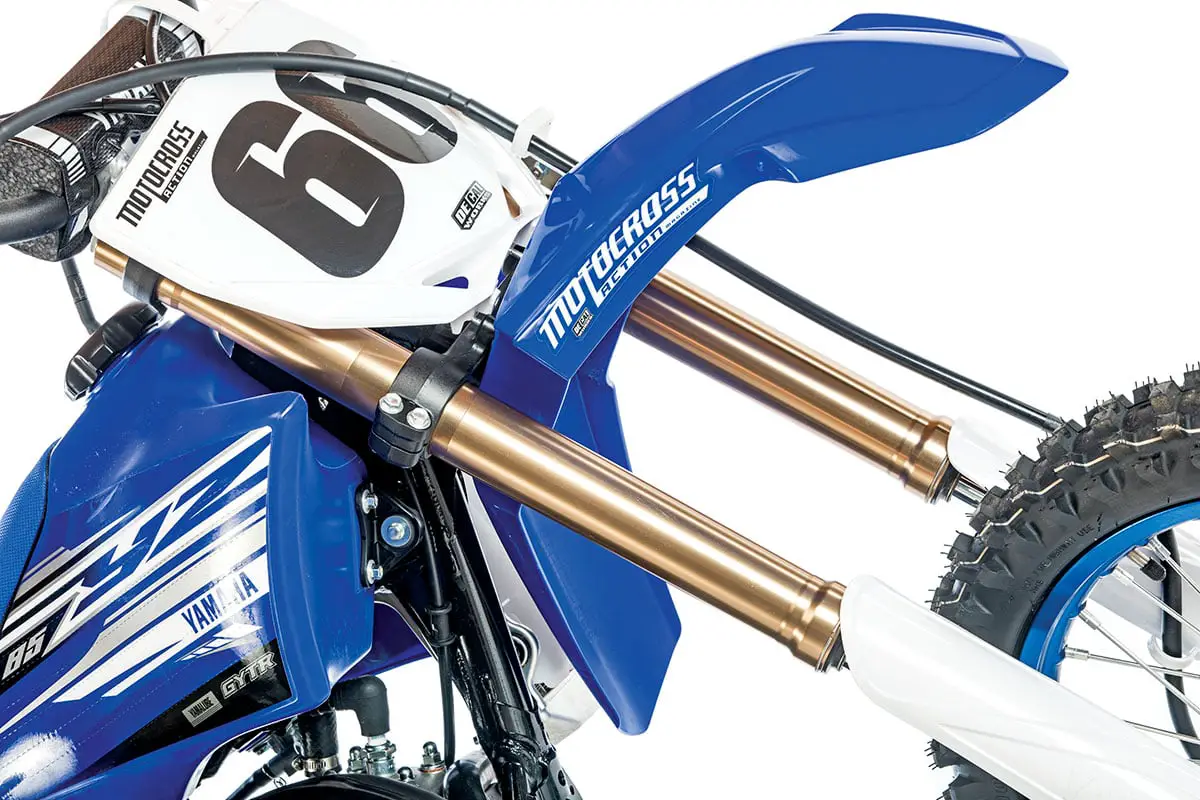
Q: WHAT DO WE REALLY THINK?
A: We applaud Yamaha for keeping its 85cc smokers alive. We appreciate that Yamaha allotted R&D money for the YZ85 and YZ65 (hopefully the YZ125 and YZ250 will be next). Mini riders are the future of our sport. Yamaha’s marketing team understands this. The younger they bleed blue, the better it is for their dealers’ bottom lines. Yamaha now offers a complete motocross line that little Johnny can grow up on, from the YZ65cc machines to the YZ450F. The 2019 YZ85 might not be earth shattering, given that it is a massaged version of an old dog, but Yamaha was able to teach it a few new tricks.

MXA’S 2019 YAMAHA YZ85 SETUP SPECS
This is how we set up our 2019 Yamaha YZ85 for racing. We offer it as a guide to help you find your own sweet spot.
KAYABA SSS FORK SETTINGS
For hardcore racing, we ran this setup on the 2019 Yamaha YZ85 (stock clickers are in parentheses):
Spring rate: 2.8 N/m
Oil height: 105cc
Compression: 12 clicks out
Rebound: 7 clicks out
Fork-leg height: 23mm up
Notes: The SSS forks can handle heavy riders and hard landings. Don’t be afraid to soften up the ride by going out on compression.
KAYABA SSS SHOCK SETTINGS
For hardcore racing, we ran this setup on the 2019 Yamaha YZ85 (stock clickers are in parentheses):
Spring rate: 49 N/m
Race sag: 80mm
Lo-compression: 9 clicks out
Rebound: 6 clicks out
Notes: The rear shock works well with the SSS forks. The balance is easy to get right. Riders chose anywhere from 75mm to 85mm of sag, depending on their personal preference. Many riders went lower in the rear to take weight off the front to lessen head-shake.
YAMAHA YZ85 JETTING FOR THE KEIHIN PWK 28mm
Here are MXA’s recommended jetting specs (when changed, stock specs are in parentheses):
Main: 145
Slow jet: 45
Needle: NBKF
Clip: 4th from top
Air screw: 1-1/2 turns


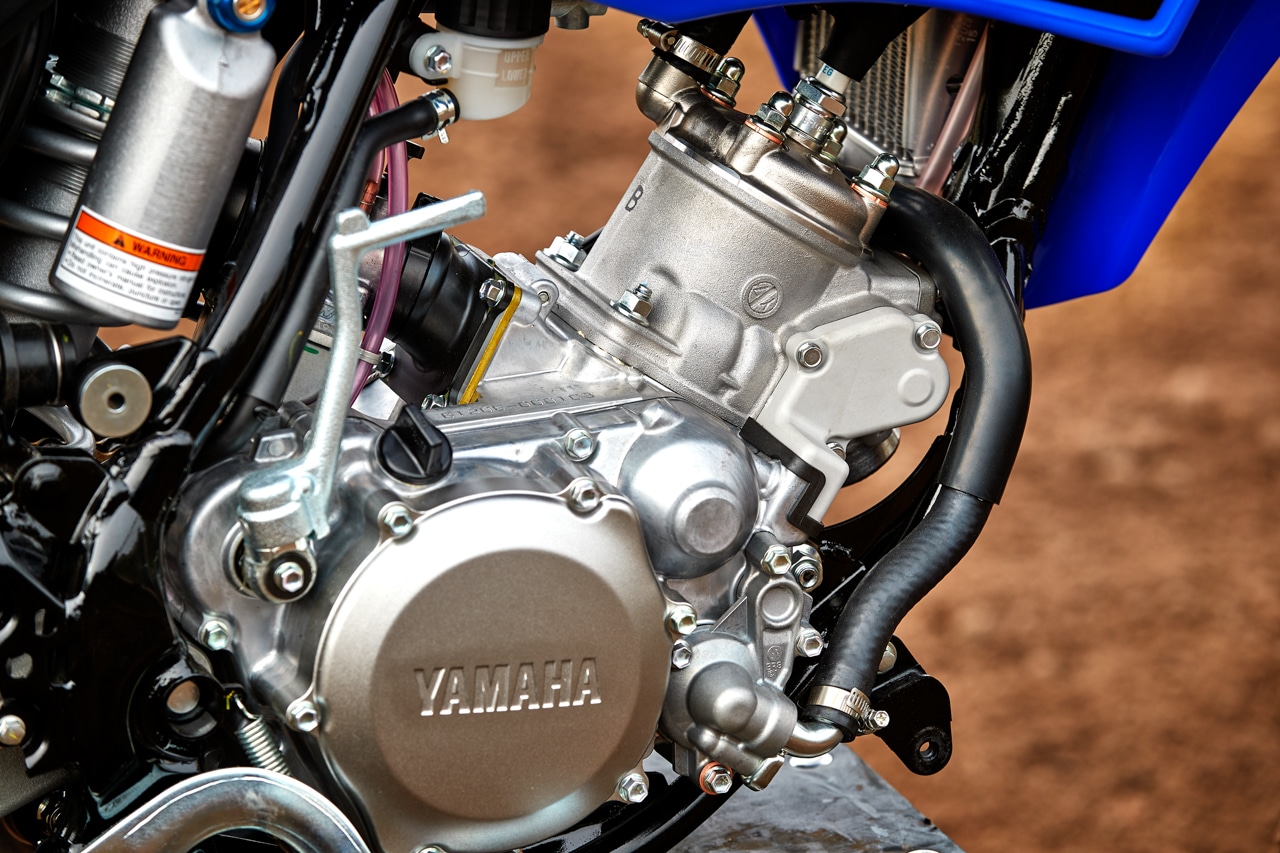
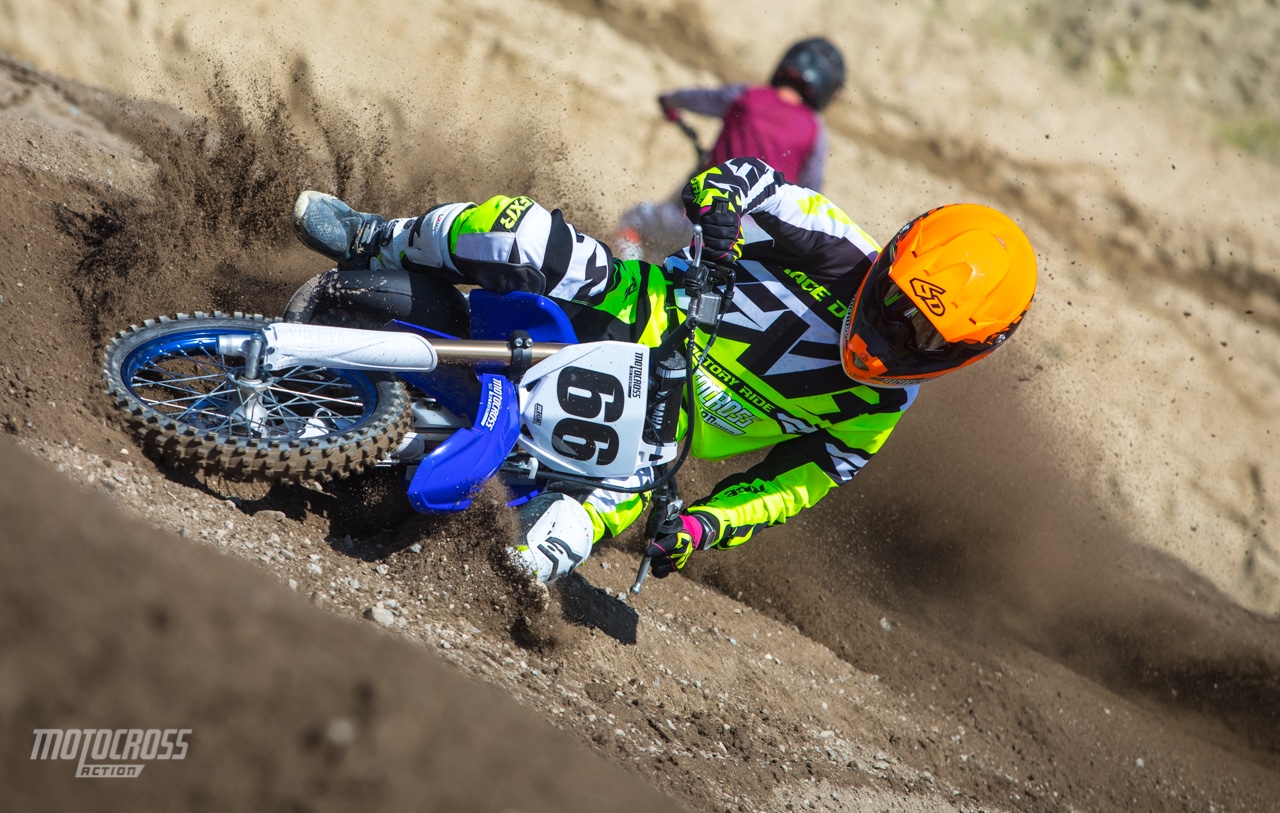

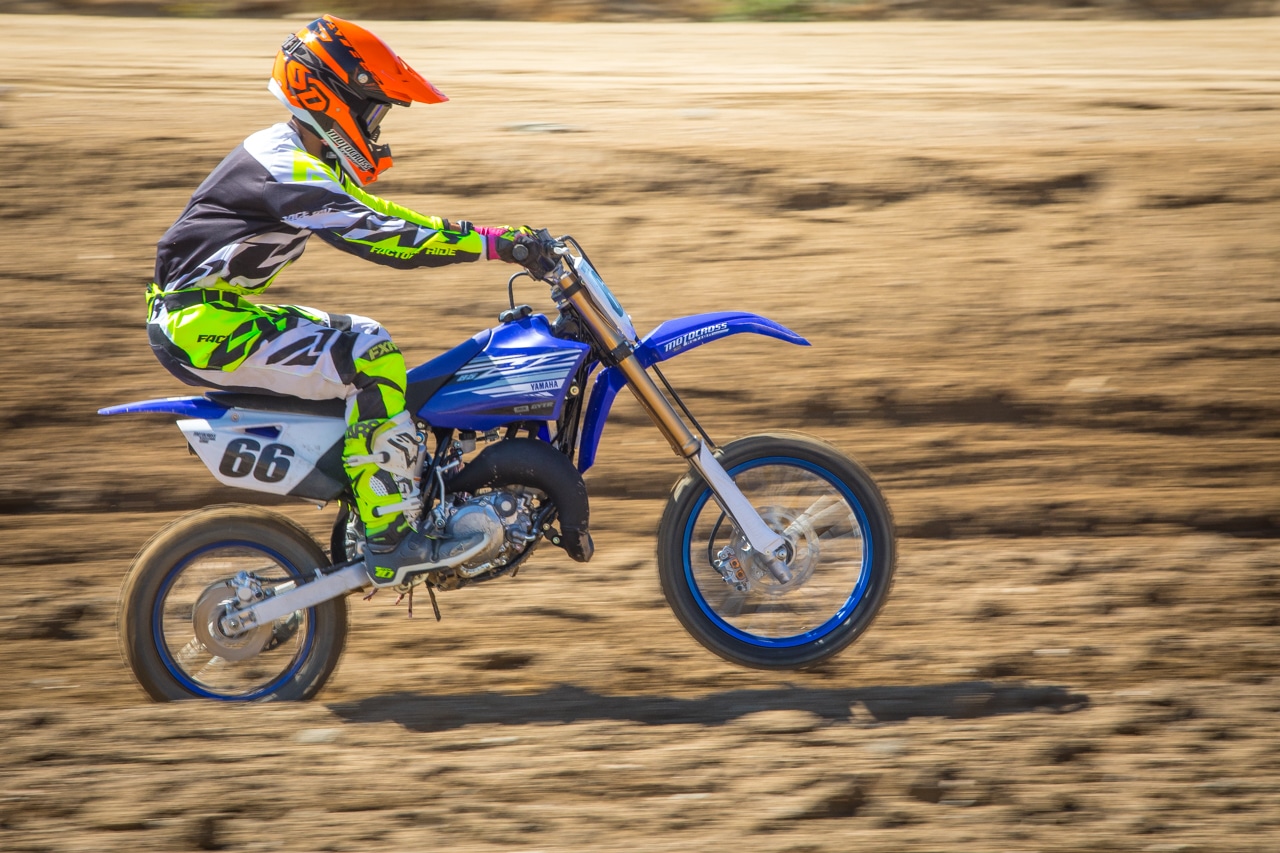



Comments are closed.